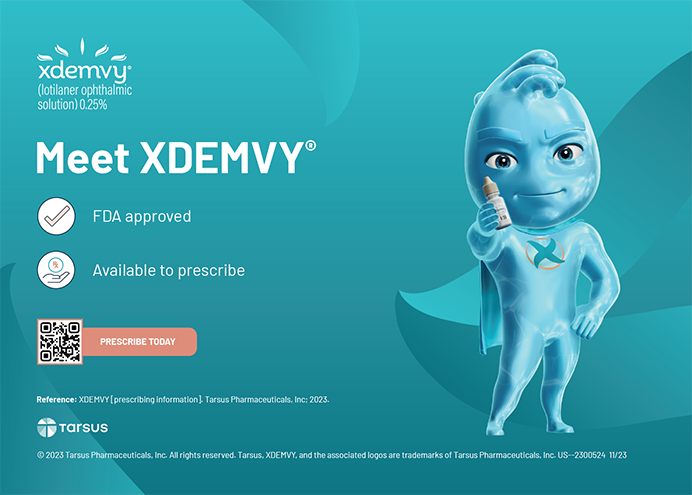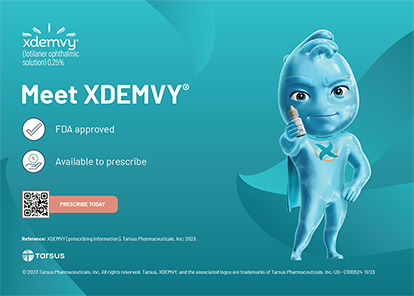For the past 2 years, ophthalmologists have been discussing consumers' relatively flat interest in refractive surgery. During this time, many refractive surgeons focused their marketing efforts on baby boomers, the population of 40- to 60-year-olds who have relatively high levels of disposable income. Instead, we should be targeting the children of the baby-boom generation—the so-called Generation Y.
NOT TOO YOUNG
A common perception among ophthalmologists is that 20-year-olds should not have refractive surgery; however, these are some of the best candidates for LASIK or other vision-correcting procedures. Because their eyes are so healthy, my staff and I have found that our younger patients achieve their targeted corrections more easily than older patients. Furthermore, a review of my practice's databases revealed that patients between the ages of 20 and 30 years required the fewest postoperative enhancements.
Recent market research shows that this age group is receptive to laser vision correction, although they do not respond as well to traditional marketing methods as their parents.1
THE MTV GENERATION
Generation Y, also known as the "MTV generation," is a marketer's dream: large, educated, and affluent. This population consists of 70 million 18- to 28-year-olds1 who collectively earn roughly $211 billion per year.2 Globally, seven out of 10 of these individuals intend to earn a degree, and one out of eight plan to study for a PhD.3
Gen-Yers are also techno-savvy, being the first individuals to come of age with computers and the Internet. They have helped turn social networking Web sites like YouTube.com and MySpace.com into phenomenal success stories (see Where to Find the Y Generation), and Gen-Yers are twice as likely as older generations to visit blog sites and actively stream and download videos and movies.
Because refractive surgery has been around during this generation's lifetime, they are more likely to know someone who has undergone LASIK. Plus, because of their affinity for technology, they will consider the procedure an alternative to eyeglasses and contact lenses. For these reasons, my staff and I believe it is time to rethink our refractive surgery marketing and the population it targets.
REALITY LASIK
To help their customers reach Generation Y, Advanced Medical Optics, Inc. (Santa Ana, CA), hired market research companies Harris Interactive (Rochester, NY) and Teenage Research Unlimited (TRU; Northbrook, IL), to identify the forms of advertising that appeal to this age group. The research groups recommended that ophthalmologists bypass traditional media outlets (ie, radio, television, and newspapers) and try a different approach to gain the trust of Gen-Yers—the Internet.
In response to these findings, Advanced Medical Optics, Inc., designed a Web-based reality program called RealityLASIK.com (Figure 1), in which Kristin Cavallari of MTV's Laguna Beach documents her pre-, intra-, and postoperative experiences with LASIK in weekly video installments. In addition to featuring explanations about the advantages of modern laser surgery by Robert K. Maloney, MD (Kristin's refractive surgeon), the "webisodes" include links to other online resources and local refractive surgeons.
To further connect with its audience, the site encourages patients to participate by posting their own experiences with LASIK, share the site with friends, and receive regular updates about the webisodes. These strategies involve users personally in the program and prompt them to recruit others, thus making LASIK a discussion topic among friends. I suggest that surgeons and administrators who are interested in working with Gen-Yers visit RealityLASIK.com to gain insight into this age group's fears and concerns.
The goal of RealityLASIK.com is to tap into Generation Y's familiarity with the Internet and online social networking. The average Gen-Yer spends 16.7 hours per week on the Internet (excluding e-mail) compared with 13.5 hours spent watching television, and up to 69 of this time on web sites such as Facebook.com.4
Kristin's surgery was also promoted through glossy magazines like InTouch Weekly and television shows like Inside Edition.5 RealityLASIK.com has received further publicity from Kristin appearing on television talk shows.
CHANGE IN DIRECTION
My colleagues and I at Durrie Vision have reconsidered our marketing efforts based on our clinical results, Advanced Medical Optics' market research, and the strategies employed by RealityLASIK.com. The nontraditional tactics we are testing include distributing leaflets at local gourmet coffee shops and handing out cards promoting our Web site at local rock concerts. These methods certainly depart from traditional ones, but we think the opportunity to reach a new generation of consumers is worth the effort.
Daniel S. Durrie, MD, is Medical Director of Durrie Vision in Overland Park, Kansas. Dr. Durrie may be reached at (913) 491-3330; ddurrie@durrievision.com.


